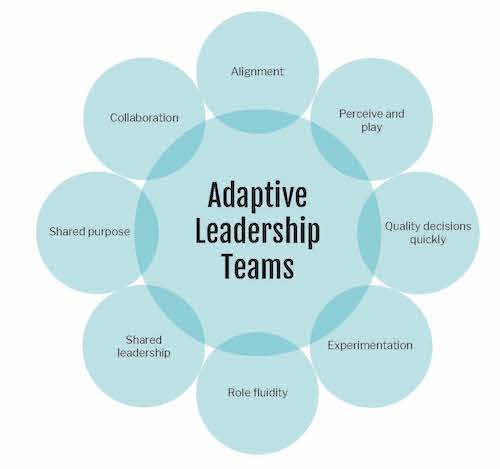In my last series of blogs, I explored the “Adaptive Leadership model. In this series, I am exploring Adaptive Leadership Teams. Leadership is a team effort. Everyone has to lead and be adaptive. My Adaptive Leadership Teams model is shown below.

Role fluidity
Role fluidity is at the heart of total football. Every player is prepared to move into another playing position as the game dictates. No player is in a predetermined role at any point.
Adaptive leadership teams move fluidly both horizontally and vertically across roles.
The players on adaptive leadership teams are able to play out of position at a moment’s notice, no matter how long they have been on the team or been playing in a particular position.
Players understand the challenges of different roles; they have respect for other roles and empathy for their perspectives.
Role fluidity emphasises teamwork and collaboration. It also raises consideration for flattening of the hierarchy and creating a more fluid, dynamic, and transitory grouping of employees forming around a particular problem or opportunity.
Role fluidity, the ability to move between various roles or activities, presents an employee with amazing opportunities and challenges. This experience not only enables the employee to grow and develop but benefits the organization from a more engaged, productive, and talented workforce.
Role fluidity can also reveal many other talents and skills an employee may have, which would not have been uncovered if they were tied to one job and title.
In our constantly changing world, static job titles embedded in a hierarchy will not allow the organization to respond. It will also cause employee disengagement and the loss of valued talent.
Shared leadership
‘No more heroes anymore.’ I am old enough to remember The Stranglers belting out that declaration back in 1977.
Leadership has to be shared and be allowed to emerge given a particular context. In a VUCA world, we cannot rely on a handful of people with grand titles to lead the organization at all times and in all situations. The leadership role can be adopted by anyone in the organization best suited to make a decision or take a particular action.
Again, here is Gore CEO Terri Kelly summing up the need for shared leadership:
‘It’s far better to rely upon a broad base of individuals and leaders who share a common set of values and feel personal ownership for the overall success of the organization. These responsible and empowered individuals will serve as much better watchdogs than any single, dominant leader or bureaucratic structure.’
One measure of Gore’s progressive, thinking-driven resilience is that in 50 years it has never made a loss and is consistently ranked as one the best places to work globally. Gore has no C-Suite, executives or managers. At Gore, leadership is shared.
Game score
Just like soccer teams, organizations have to have adaptive leadership teams if they are to beat the opposition and win the competition.
They have to align around a common goal, perceive what is happening outside the organization and respond accordingly. Sound decisions need to be made quickly and teams will experiment to discover what works and what doesn’t.
There is role fluidity and anyone can play in any position depending on what is required.
There is shared leadership with a shared purpose and widespread collaboration and innovation as a result
When organizations have adaptive leaders and adaptive leadership teams, they are true champions.
My next posts will explore further aspects of the Adaptive Leadership Teams model.
Article by channel:
Everything you need to know about Digital Transformation
The best articles, news and events direct to your inbox
Read more articles tagged: Featured, Leadership







